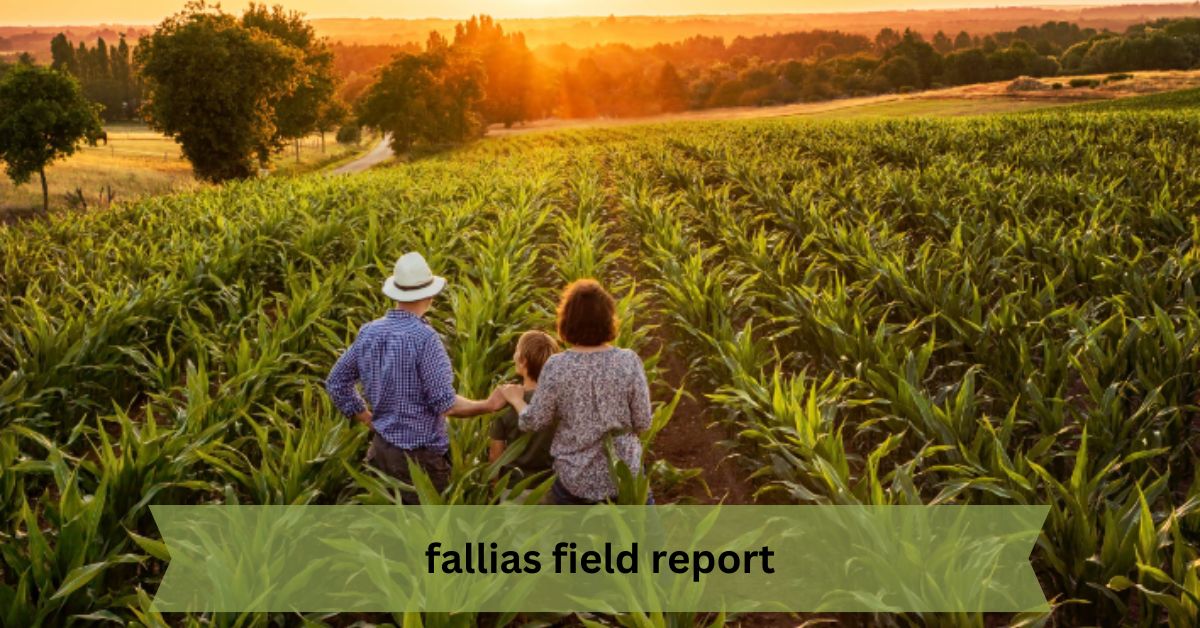The Fallias Field Report is an essential tool for documenting fieldwork and sharing findings with colleagues, stakeholders, and the broader research community. In any field-based research or project, collecting accurate and detailed data is crucial for success.
What Is a Fallias Field Report?
A Fallias Field Report is a structured document that provides detailed information on the activities, observations, and findings gathered during fieldwork.
Whether it’s used for environmental studies, construction site evaluations, social research, or any other field-based activity, the field report is a cornerstone for communicating what was done, what was observed, and the conclusions drawn from those observations.
The main goal of this report is to record the data collected in the field and make it accessible for future reference. It’s also a way to ensure transparency in research, as the report serves as a record of the methodologies used and the outcomes of the project.
Why Is the Fallias Field Report Important?
- Accurate Data Collection: The Fallias Field Report helps in collecting data systematically, which is essential for ensuring that findings are reliable and can be verified.
- Facilitating Communication: It allows team members, stakeholders, and the research community to understand the fieldwork process, methods, and results.
- Improving Decision-Making: Well-documented field reports offer crucial insights that can shape future decisions and improve project outcomes.
- Accountability and Transparency: When documenting the findings of a project, having an organized report ensures that all steps are accounted for, providing transparency for all parties involved.
Components of a Fallias Field Report
Creating an effective Fallias Field Report involves several key components. Each section plays a vital role in capturing and conveying the information gathered during fieldwork.
1. Title of the Report
The title should clearly state what the field report is about. It could include the location of the fieldwork, the subject of study, and the date. For example: “Fallias Field Report on Environmental Impact of Construction Sites – August 2024.”
2. Introduction
In this section, you will provide background information on the fieldwork, including:
- Objective: What is the purpose of the fieldwork? For example, are you assessing environmental impacts, collecting social data, or evaluating infrastructure?
- Location: Where did the fieldwork take place? Providing a detailed geographical description can be critical for readers to understand the context.
- Dates: When did the fieldwork occur? Mention the specific dates or the duration of the study.
- Team Members: Who conducted the fieldwork? Include the names and roles of all team members involved.
3. Methodology
The Methodology section outlines how the data was collected during the fieldwork. This is a crucial part of the Fallias Field Report because it shows the validity of your findings. Be sure to include:
- Tools and Equipment: What instruments or technologies were used to gather data?
- Techniques: What specific methods were applied for data collection? This could involve surveys, sampling, direct observations, or the use of sensors.
- Procedure: How was the fieldwork carried out, and what steps were followed?
4. Observations
The Observations section is where you provide detailed accounts of what was observed during the fieldwork. This might include:
- Environmental Conditions: Describe weather, climate, and other environmental factors that may have impacted your findings.
- Physical Observations: What physical objects or phenomena did you observe? This could include landscapes, wildlife, infrastructure, or other elements depending on the nature of your fieldwork.
- Social Interactions: If the fieldwork involves human subjects, describe the interactions, interviews, or behavioral patterns observed.
5. Data and Findings
This section should present the data that was collected during the fieldwork. Depending on the nature of the study, data might be presented in tables, charts, or written summaries. Ensure you include:
- Raw Data: Any measurable data that was collected, such as temperature readings, survey responses, or material quantities.
- Analysis: Provide interpretations of the raw data. What does the data mean in the context of the fieldwork? Highlight any trends, patterns, or significant findings.
- Significant Findings: If certain findings stand out as particularly important, mention them here with detailed explanations.
6. Discussion
In the Discussion section, you will interpret the findings more deeply. Explain what the data means, whether it supports the objectives of the fieldwork, and how it compares with other studies or expectations.
The discussion should also explore any limitations encountered during the fieldwork and suggest areas for further study.
7. Conclusion
The Conclusion summarizes the key points of the Fallias Field Report. It reiterates the purpose of the fieldwork, the most important findings, and any recommendations for future action. The conclusion should be concise, providing a snapshot of what the report has covered.
8. Recommendations
This section offers actionable suggestions based on the findings. These recommendations might be directed at policymakers, project managers, or researchers and should be clear and well-justified.
9. Appendices
Include any supplementary materials in the Appendices. This might include:
- Maps
- Photographs
- Raw Data Tables
- Additional Notes
How to Write an Effective Fallias Field Report
Writing a Fallias Field Report is more than just recording data—it’s about presenting information in a clear, organized, and accessible manner. Below are some tips for writing an effective report:
1. Be Clear and Concise
The report should avoid jargon and complex language. It needs to be accessible to all readers, regardless of their technical background. Use simple, direct language to explain your findings.
2. Stay Organized
The structure of the report is essential for clarity. Ensure that each section flows logically from one to the next. Proper headings, subheadings, and bullet points can help organize information efficiently.
3. Include Visuals
Where applicable, include visuals such as charts, graphs, maps, and photographs. Visuals can help clarify complex data and make the report more engaging.
4. Keep Your Audience in Mind
Consider who will be reading your report—whether it’s a research team, policymakers, or stakeholders. Tailor your language and focus to meet their needs, ensuring they can extract the most valuable information from your report.
5. Provide Insights and Analysis
Don’t just present raw data—interpret it. Offer insights into what the data means and how it impacts the broader goals of the project or study. Providing a deeper level of analysis helps elevate the value of the report.
Benefits of Using the Fallias Field Report for Various Industries
The Fallias Field Report is a versatile tool that can be adapted for use in various industries. Below are some ways different sectors benefit from using structured field reports:
1. Environmental Research
Environmental scientists and researchers use field reports to document changes in ecosystems, monitor pollution levels, or track wildlife patterns. The Fallias Field Report offers a standardized format to record and analyze these changes, providing valuable data for conservation efforts and policy-making.
2. Construction and Engineering
In construction and engineering projects, field reports help track the progress of a project, evaluate safety protocols, and assess site conditions. Engineers can use these reports to identify potential issues and take corrective measures before problems arise.
3. Social and Market Research
Social researchers use field reports to record interactions, interviews, and behavioral observations in communities or focus groups. These reports allow researchers to document firsthand experiences and provide insights into social dynamics, cultural norms, or consumer behavior.
4. Agriculture and Ecology
In agriculture, field reports are used to track soil conditions, monitor crop health, and record environmental factors that affect yield. Ecologists use field reports to track species diversity, habitat conditions, and changes in ecosystems over time.
5. Business and Project Management
For businesses managing multiple sites or projects, field reports provide a way to maintain accountability and track progress. Regular field reports ensure that stakeholders stay informed and can make timely decisions based on accurate data.
Frequently Asked Questions
1. What should be included in a Fallias Field Report?
A Fallias Field Report should include the title, introduction, methodology, observations, data and findings, discussion, conclusion, recommendations, and appendices. These components ensure comprehensive coverage of the fieldwork.
2. Why is the Fallias Field Report important?
The Fallias Field Report is important because it ensures accurate data collection, facilitates communication between teams and stakeholders, and improves decision-making through well-documented insights.
3. How can I make my Fallias Field Report easy to read?
To make your Fallias Field Report easy to read, use clear language, avoid technical jargon, and organize the report with headings, subheadings, and bullet points. Visual aids like charts and maps can also improve readability.
4. Who can benefit from using a Fallias Field Report?
Various industries, including environmental research, construction, social research, agriculture, and business management, can benefit from using a Fallias Field Report for better data organization, accountability, and communication.
5. How often should field reports be created?
The frequency of creating field reports depends on the nature of the project. In long-term projects, field reports may be generated at regular intervals, such as weekly or monthly, to track progress and changes over time.
In conclusion, the Fallias Field Report is an indispensable tool for documenting fieldwork, collecting data, and sharing findings with stakeholders. Whether you’re working in research, construction, or business, an organized and well-structured field report can significantly enhance the transparency, accountability, and overall success of your project.



